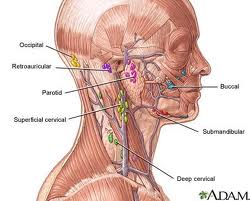SEE ALSO, EARLIER POST: The Lymphatic System [Feb 25, 2011, A general overview with a discussion
of poses]
Wikipedia.com: SEM
Lymphocyte
A MICRO VIEW: As with the cardiovascular system, the
lymphatic system attends to every cell.
Lymph fluid enters the process as fluid leaking out of slits as “plasma”
from the blood capillaries, and as intracellular fluid that seeps out of
billions of cells. There is a
“dance,” of sort of give-and-take, between the lymph and blood. Pressure from the pumping blood system
leaks fluid out of the blood capillaries, along with the loss of intercellular
fluid, right into the micro lymph channels. The cellular edges of the lymph channels are more like
hinged flaps that take in fluid in a one-way direction back toward the central body.
lymphnotes.com
Even though, there is 2-3 times more lymph fluid than blood,
the largest volume of “waste”—ninety percent—is removed by the circulatory
system. The lymph system expels larger molecules that do not “fit.” Lymph channels eventually flow largely
back into the cardiovascular system.
The lymphatic system is crucial in vertebrate
immunology. Along the routes, this
lymph fluid passes through between 500-700 lymph nodes. Small [not always very visible without
radioactive measures] and bean shaped, the nodes filter the incoming
fluid. They are porous yet more
like spongy filters wherein “immune cells” termed “lymphocytes” cling due to
the specialized nature of the sinus tissue. The lymphocytes sense substances [“antigens”] secreted by
“pathogens”—irregular cells or invaders such as bacteria. The lymphocytes produce
“antibodies” that target “pathogens.”
Lymphocytes are white blood cells produced primarily in bone
marrow. White blood cells in the
lymphatic system are B-Type and T-Type cells. B-Types [bursa-derived] go to the spleen and lymph nodes to
challenge bacteria and viruses.
T-types [thymus] go the thymus where they mature and then move to nodes
to challenge pathogen-infected/mutant cells, but the thymus shrinks in
adulthood.
acm.uiuc.edu
Swelling nodes in
sore throats are gross indicators that large numbers of immune cells are being
channeled to the lymph nodes. Swelling
body tissue can result from poor lymphatic
circulation where movement may be restricted due, for example, to lack of
movement, injury, radiation or surgery that removes or scars channels/nodes and
impedes flow.
lymphnodecancerblog.com
YOGA & LYMPH:
Seated on an airplane for some time, the feet may begin to
swell. What is occurring is an
absence of movement. The
role of movement [breath and posture] in yoga practice may enhance the function
of the lymphatic system. The
compression and extension and inversion of the body that occurs in asanas [poses] “pump” the lymphatic system in a rich
variety of ways.
Yoga offers a practice experience that is quite
comprehensive in its range of movement.
Intentional breath work intensifies movement of the diaphragm “pumps”
the lymph system from head to pelvis.
Muscles pump lymph fluid.
The spine is moved in many directions. The body is frequently inverted whenever the head is lowered
rather than kept upright as in many popular forms of exercise.
Gentle forms of body-mind practices are appropriate for nearly
every person. RESTORATIVE YOGA is not only accessible to most people, but also
spends time in a variety of poses that allow more time for compression and
drainage. Also, the quiet of
restorative-yin yoga stresses an often-overlooked element: A strong
counter-response to “stress” involves quieting and calming and “relaxation.”
BEYOND YOGA, there is the possibility of directly massaging
lymph tissue. “Manual Lymphatic
Drainage Massage” is sometimes cited as useful, particularly in the treatment
of edema resulting from surgery to remove lymph nodes or from scarring from
radiation treatment. Either a
masseuse-directed intervention or a self-directed intervention is oriented
toward removing excess fluid from blocked areas causing irritating edema. A physician that is specifically
involved in your treatment should be consulted to see if MLD massage is
recommended [due to the concern with spreading/facilitating the distribution of
malignant cells]. Generally,
recommended by a physician for massage intervention, people are encouraged to
seek out massage therapists skilled in lymphatic massage, and to not
automatically trust that the therapist is skilled in this particular area.
Massage might focus on nodes around ears, behind and in
front of ears, armpits, elbows, abdomen, and behind knees. Generally,
self-massage of the lymph nodes for persons without clinical issues might
involve:
- Rubbing hands together
- Warming hands over eyes
- Rubbing forehead back over ears
- Rotating inner surface of ear, with finger
- Pinching under nose and sliding hand down face
- Massaging upper jaw
- Massaging esophagus
- Massaging inside of upper arm to armpit
- Massaging shoulder then squeeze down arm
- Massage hand and twist each finger
- Hands pressuring inner legs
- Down calf and shin
- Ankle joint
- Thumb into bottom of feet, an between toes
lymphedemapeople.com
Self-message is not unlike pressure on “acu-points” on face,
feet, hands, and elsewhere.
The limiting factor for self-massage is likely to be time itself. How much time is available and how is
time to be prioritized?
yourmedicalguide.blogspot.com
Focusing on hands and/or feet or details of the feet or neck
or face may not be as practical or even as beneficial as a more comprehensive
movement of the body. Focusing on
a specific area of the body may be worth the effort when the specific area is
deemed to be an issue. Yoga can
become a specific practice of “acu-yoga,” wherein poses are selected to
concentrate on specific body regions.
But the sequences of yoga poses found in most practices tend to offer a
rather comprehensive intervention.






i do not see a sept 25 2011 entry. i am quite interested in reading it. ty
ReplyDeleteSorry, Find The Lymphatic System Feb 25, 2011.
ReplyDelete